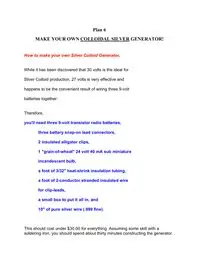
Plan 6 CS Generator PDF
Preview Plan 6 CS Generator
Plan 6 MAKE YOUR OWN COLLOIDAL SILVER GENERATOR! How to make your own Silver Colloid Generator. While it has been discovered that 30 volts is the ideal for Silver Colloid production, 27 volts is very effective and happens to be the convenient result of wiring three 9-volt batteries together. Therefore, you'll need three 9-volt transistor radio batteries, three battery snap-on lead connectors, 2 insulated alligator clips, 1 "grain-of-wheat" 24 volt 40 mA sub miniature incandescent bulb, a foot of 3/32" heat-shrink insulation tubing, a foot of 2-conductor stranded insulated wire for clip-leads, a small box to put it all in, and 10" of pure silver wire (.999 fine). This should cost under $30.00 for everything. Assuming some skill with a soldering iron, you should spend about thirty minutes constructing the generator. Solder your three snap-on battery clips in series (red to black) to provide 27 volts. Connect a 24V incandescent lamp in series with either positive or negative output lead. Solder the red insulated alligator clip to the positive (anode) and the black insulated clip to the negative (cathode) 2-conductor lead wires. Insulation is shrunk over soldered connections using a heat gun or hair dryer. Cut your 10" of silver wire in half. Bend top ends of your two 5" silver electrode wires so they can clip over the top rim of a plastic or glass cup (not metal). About 4" of each wire should be submerged. WARNING! Use ONLY pure silver (.999 fine) electrodes. #14 gauge is the preferred thickness. Pure silver is sometimes available at electroplating supply companies. Or, inquire at a jewelry store specializing in silver about who their wholesale supplier is. Do not use sterling silver (.9275) since sterling contains copper and nickel. NICKEL CAN BE TOXIC. (With this in mind, you may want to have a chemical analysis (assay) of your purchased silver in addition to the written word of your supplier.) If the Silver Colloid is to be ingested or injected, be sure to use distilled water. Tap water is fine for other uses, such as for a topical spray or for plants. Also, before beginning to make your Colloidal Silver you will need to make a saline solution for enhancing conductivity. ************************************************************************************** NOTE: Two points of interest; 1) DO NOT USE SALT - just use distilled water 2) An ingot of silver cut in half works better than wire ************************************************************************************* Saline solution can be made by mixing six ounces of distilled water with one tea- spoon of sea salt in a separate container. Do not use common table salt as table salt has chemical additives. After stirring the salt solution, pour some of the water into an eye dropper bottle. Now you're ready to make Colloidal Silver. Pour eight ounces of water into your glass. Add 1 or 2 drops of saline solution (3 drops at the most; if you use too much salt, you'll be making silver chloride instead!) to distilled water and stir with a plastic/non-conductive utensil. Insert silver electrode wires. Placement of wires is not critical, but they must not be touching each other or the process will stop. (You cannot shock yourself in this process so do not be concerned.) Attach alligator clips to the ends of the silver electrode wires coming over the outside rim of the glass and you will see a grey mist inside the glass start to peel away from the positive polarity wire while bubbles of hydrogen rise from the other. Laboratory tests show that this method creates a silver colloid of approximately 1 ppm per minute of activation time. Since you are only taking microscopic particles from the silver wire, your silver wire may very well last for years. The brightness of the light bulb is related to the conductivity of the water. It is not necessarily a problem if the bulb is very dim or even remains dark as long as the process itself is occurring. (If the bulb is dark you can always consider adding one more drop of saline solution next time.) Do not add saline solution after process has begun. Of course, when batteries are old, the light will also become dimmer, signaling it's time for a change. Touch the two alligator clips together to test the brightness of the bulb as a battery check. A fresh set of three alkaline batteries should make several hundred thousand batches of concentrated Silver Colloid. Also, put a few drops of Silver Colloid in the saline solution to prevent fungus growth. When finished, detach alligator clips. Clean silver electrode wire after each use to remove dark oxide on the anode. Use a small piece of 1/4" thick nylon kitchen scouring pad to polish dried silver, then wipe with paper napkin to make ready for next use. Store your Colloidal Silver in dark, non-conductive (and if plastic, non-reactive) containers, like empty hydrogen peroxide bottles. Keep away from light as even room light will degrade colloids rapidly by turning solution grey or black just as exposure to light darkens the silver in camera film. Stir thoroughly or shake each time before using. Keep cool, but do not refrigerate. In using your own home-made silver colloid generator it will become apparent that you now have the power to safely protect yourself, your family, your pets and plants, your community, and (through the dissemination of this information), our nation, from over 650 pathogens, viruses, microbes, fungi and parasites. Upon creating your first batch of Colloidal Silver, you will find it tastes the same as untreated water. And it won't sting, even in a baby's eyes.
